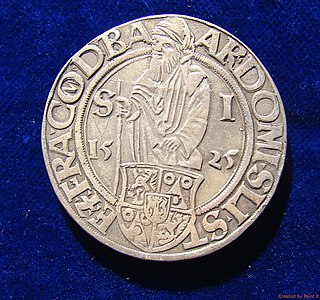This page is based on this
Wikipedia article Text is available under the
CC BY-SA 4.0 license; additional terms may apply.
Images, videos and audio are available under their respective licenses.

Guilder is the English translation of the Dutch and German gulden, originally shortened from Middle High German guldin pfenninc "gold penny". This was the term that became current in the southern and western parts of the Holy Roman Empire for the Fiorino d'oro. Hence, the name has often been interchangeable with florin.
Gulden (help·info) is the historical German and Dutch term for gold coin, equivalent to the English term guilder.

The thaler was a silver coin used throughout Europe for almost four hundred years. Its name lives on in the many currencies called dollar and the Samoan tālā, and, until recently, also in the Slovenian tolar.

The ducat was a gold or silver coin used as a trade coin in Europe from the later Middle Ages until as late as the 20th century. Many types of ducats had various metallic content and purchasing power throughout the period. The gold ducat of Venice gained wide international acceptance, like the medieval Byzantine hyperpyron and the Florentine florin, or the modern British Pound sterling and the United States dollar.

The Krone or korona was the official currency of the Austro-Hungarian Empire from 1892 until the dissolution of the empire in 1918. The subunit was one hundredth of the main unit, and was called a Heller in the Austrian and a fillér in the Hungarian part of the Empire.

The Kreuzer, in English usually kreutzer, was a silver coin and unit of currency existing in the southern German states prior to the unification of Germany, and in Austria. After 1760 it was made of copper.

The Vereinsthaler was a standard silver coin used in most German states and the Austrian Empire in the years before German unification.

The rijksdaalder was a Dutch coin first issued by the Republic of the Seven United Netherlands in the late 16th century during the Dutch Revolt. Featuring an armored half bust of William the Silent, rijksdaalder was minted to the Saxon reichsthaler weight standard – 448 grains of .885 fine silver. Friesland, Gelderland, Holland, Kampen, Overijssel, Utrecht, West Friesland, Zeeland, and Zwolle minted armored half bust rijksdaalders until the end of the 17th century.
The Gulden was the currency of the states of southern Germany between 1754 and 1873. These states included Bavaria, Baden, Württemberg, Frankfurt and Hohenzollern.
This specific Gulden was based on the Gulden or florin used in the Holy Roman Empire during the Late Middle Ages and Early Modern period.
The pound was the currency of the Kingdom of Lombardy-Venetia.
The gulden was the unit of account of the Dutch East Indies from 1602 under the United East India Company, following Dutch practice first adopted in the 15th century. A variety of Dutch, Spanish and Asian coins were in official and common usage. After the collapse of the VOC at the end of the 18th century, control of the islands reverted to the Dutch government, which issued silver 'Netherlands Indies' gulden and fractional silver and copper coins until Indonesian independence in 1948.
Italy has a long history of different coinage types, which spans thousands of years. Italy has been influential at a coinage point of view: the florin, one of the most used coinage types in European history, was struck in Florence in the 13th century. Since Italy has been for centuries divided into many city-states, they all had different coinage systems, but when the country became unified in 1861, the Italian lira came into place, and was used until 2002. Today, Italy uses the Euro.
Rhenish guilder is the name of the golden, base currency coin of the Rhineland in the 14th and 15th centuries. Most were about the size of a modern US dime and weighed between 3.4 and 3.8 grams.
















